Particle Pollution
And Why You Should Never Take It For Granted
The World Health Organization (WHO) in their most recent report on the subject stated that in 2019 alone, combined indoor and outdoor air pollution is estimated to have contributed to almost seven million premature deaths worldwide. Overall, that is 12 percent of global deaths. Taken into perspective, that is more than twice as many deaths from alcohol consumption and five times more than from traffic accidents.
What Is Particle Pollution?
Particle pollution is made of tiny solid particulates mixed with liquid droplets that are in the surrounding air. These particles are in the form of smoke, ash, black carbon (soot), rubber dust from tire ware, fumes, micro plastic, pollen, bacteria, viruses, etc. Nothing about these pollutants are simple and in fact are so dangerous that these will shorten your life.
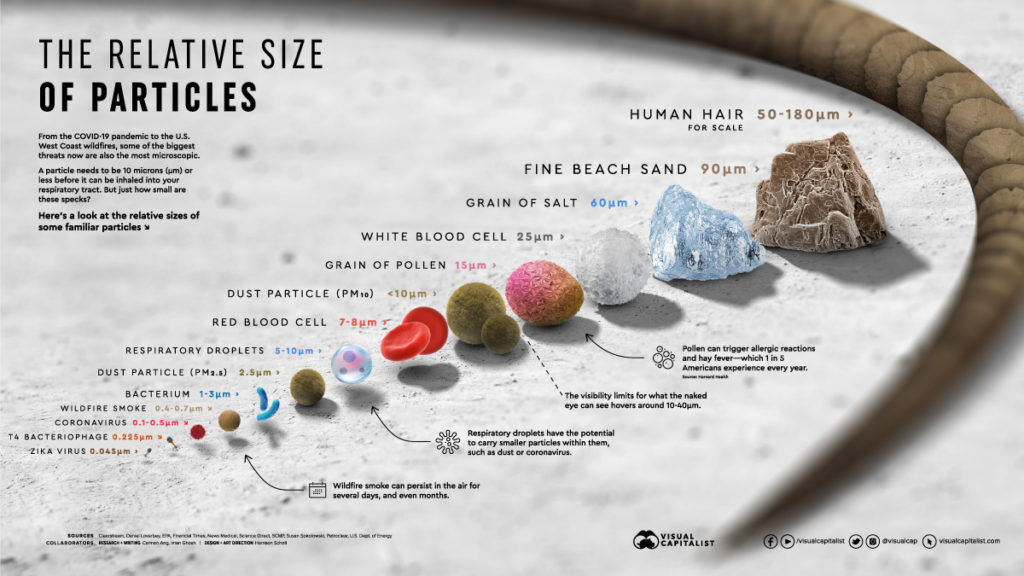
The particles are of varying sizes. Some are one-tenth the diameter of a strand of hair while others are so tiny that they can only be seen thru an electron microscope. No matter what the size, these particles will harm your health.
Particle pollutants are categorized as follows:
PM10 : Referred to as coarse particles with a diameter of 10 micrometers (or 0.010 millimeter) and less
PM2.5 : Fine inhalable particles with a diameter of 2.5 micrometers (0.0025 millmeter) and less
PM0.1 : Ultrafine particles with a diameter of less than 0.1 micrometer (0.0001 millimeter)
Airborne particles have different physical diameters and density and for convenience, the term aerodynamic diameter of an idealized spherical particle is used. Simply put, it refers to particle size. Particles of the same aerodynamic diameter may therefore have different dimensions and shapes.
PM Composition
Particulate matter, which is one type of pollutant (others being gas and biological molecules), can be composed of different compounds. This may include soil or dust particles, acid nitrates and sulfates, organic chemicals, and metals.
Not all are solid as some are liquids, and some are solids mixed with liquids.
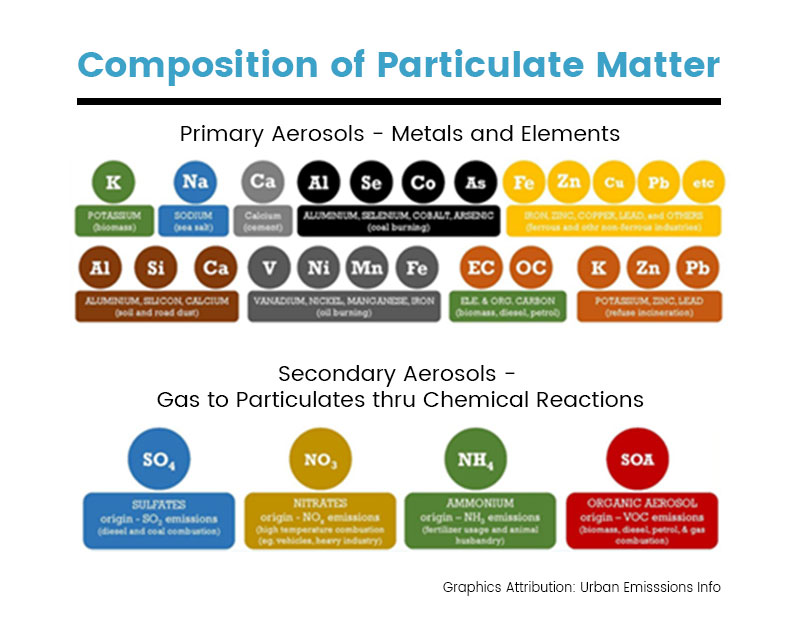
Some particles originate directly from a source such as from construction sites, unpaved roadways, biomass, smokestacks, or fires. These are referred to as primary particles that are made up of metals and elements.
Other particles are brought about through atmospheric reactions between chemicals emitted from power plants, industries and automobiles and the atmosphere, thereby creating secondary particles.
Indoor Sources
Air pollution of course is not just from sources found outdoors that are originating from industrial smokestacks or hundreds of cars in gridlock traffic. Air pollution is also very much found inside the luxury of our homes.
According to the US EPA, levels of indoor air pollutants in fact are often 2 to 5 times higher than outdoor levels, and can even exceed 100 times for some pollutants.
Indoor particulate matter may be a mix of substances that originated from outside, such as pollen, fungal spores, endotoxin (a toxin present in bacteria), carbon (soot), and different chemical pollutants that attach to particles.
The most common indoor sources of fine particulate matter include mould, tobacco smoke, cooking related, and even from hobbies and renovation activities that create dust, improperly installed furnaces or fireplaces, and smoke produced from burning candles and incense.


How particle pollutants affect the body
The respiratory system is essential in bringing in the oxygen to “oxygenate” the blood to revitalize each and every vital organ of the body for all these to work properly. At the same time, it is also the same respiratory system that brings out harmful carbon dioxide in exchange for the oxygen.
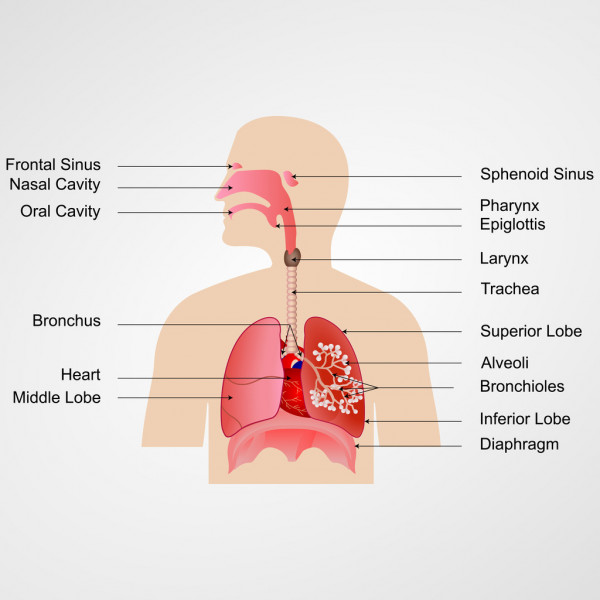
Oxygen passes through the two parts of the respiratory system, first through the upper respiratory tract composed of the nose, nasal cavity sinuses, larynx, and trachea. Then through the lower respiratory tract starting from the lungs, bronchi and bronchioles, all the way to the air sacs called the alveoli, before it reaches the bloodstream. Carbon dioxide in turn during the gas exchange are extracted from the bloodstream goes through the same tracts in reverse.
There is the chance that you will inhale particulate matter in the air. How far the particulate matter goes into the respiratory system, and what happens when these are deposited, depends on the size, shape, and density, as well as chemical and toxic properties of the particulate matter.
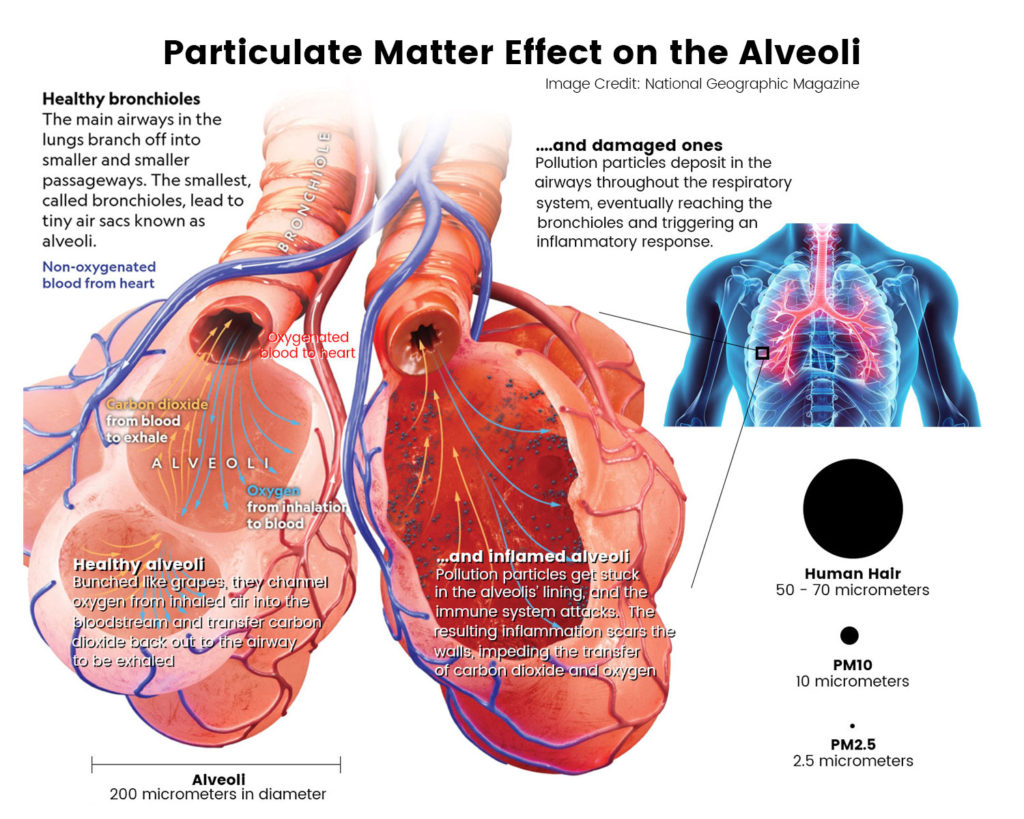
Some PM10 particles can be coughed or sneezed out if these are merely lodged in the nose, mouth or throat. However, those defenses will not keep out all from penetrating further down the upper part of the respiratory system, even all the way to the lungs.
PM2.5 particles can settle not only on the walls of the lungs but even enter the air sacs (aveoli) where the oxygen and carbon dioxide exchange occurs. PM0.1 particles are so minute that they can reach the inner organs through the bloodstream.
Four Ways Particulate Matter is deposited in the Lungs
Interception
A particle is deposited when it travels so close to a surface of the airway passages that an edge of the particle touches the surface. For example, asbestos fibres with a diameter of 1 µm (PM2.5) and a length of 200 µm would be deposited in the bronchial tree.
IMPACTION
Particles tend to travel along their original path when they are suspended in air. Depending on the velocity and mass, the particle will not turn with the air flow when there is a bend in the airway system and as a result will impact or stick to a surface. So typically particles greater than 10 µm (PM10) in diameter are deposited in the nose or throat and cannot penetrate further down the respiratory system.
Sedimentation
Gravitational forces and air resistance will prevent particles from staying up in the air, resulting to these eventually settling on the surface. This type of deposition is most common in the bronchi and the bronchioles part of the respiratory system. When the particle however is less than PM0.1, sedimentation is not an important factor
Diffusion
Particles of PM0.1 in diameter moves in random motion similar to gas molecules. The smaller the particle size, the more vigorous the movement is. Diffusion is the most critical mechanism for deposition in the small airways and alveoli where the air exchange between oxygen and carbon dioxide occurs. Very fine particles PM0.1 or smaller therefore can even reach all the way to the bloodstream.
What Are The Health risks?
Particle pollution affects breathing and health conditions, such as:
- asthma
- allergies
- chronic obstructive pulmonary disease
Because it can go all the way to the bloodstream, particle pollution also affects hearth conditions, such as:
- angina
- arrhythmia
- heart attack
- heart failure
- hypertension
Indoor pollutants and bacteria are also related to specific risks such as asbestosis and Legionnaire’s disease.

PM2.5 and lower sized particulate matter are so microscopic and therefore can reach the bloodstream, all vital organs within the body may be in danger.
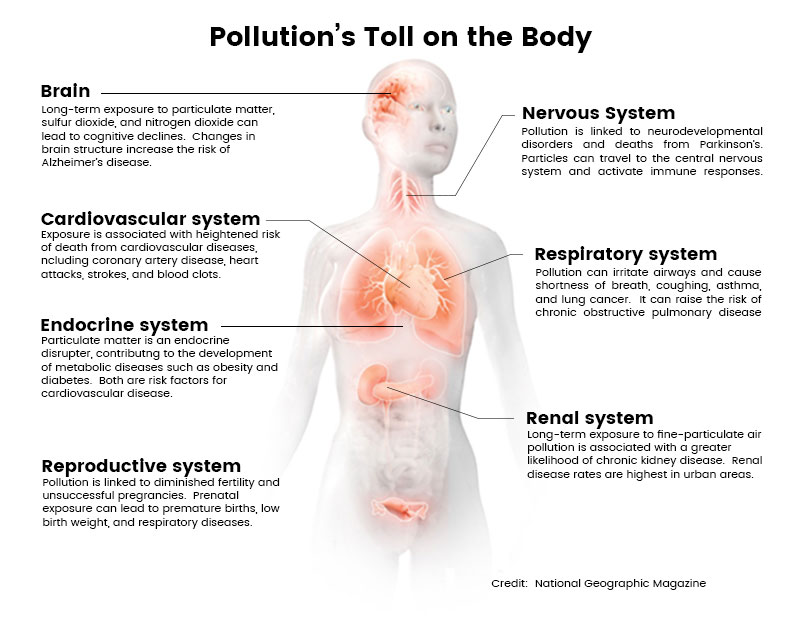
Who are most at risk
Just about anyone is at risk where ever particle pollution levels are high. But those that face higher risks from exposure include:
- Infants, children and teens who suffer from allergies;
- People with lung disease, especially asthma, but also people with chronic obstructive pulmonary disease (COPD);
- People with cardiovascular disease;
- Current or former smokers; and
- People who are obese.
Reducing exposure in the home
The best way to reduce fine particulate matter indoors is to remove sources that produce it and reduce how much sources produce.
Efforts should be done doing the following:
- Clean with a mop, a damp cloth, and HEPA vacuum.
- Keep the home free of tobacco smoke
- Reduce the use of candles and incense
- Do any cutting and sanding outdoors for renovation projects when possible.
- Ensure that wood stoves, fireplaces, and wood stoves are working properly and maintained according to manufacturer’s directions.
- Use exhaust fans when cooking.
- Indoor relative humidity (RH) should be kept below 60 percent – ideally between 30 percent and 50 percent, if possible to prevent too much water vapour that can create mould and even encourage dust mites. (caption: exposure to high levels of indoor dampness can reduce lung function and cause chronic health problems such as asthma
- Never leave a vehicle idling while in your attached garage or near doors and windows.
- Do not use a barbeque or generator indoors or inside the attached garage.
- Ventilation can help reduce indoor fine particulate matter levels by removing emissions from indoor sources like cooking.
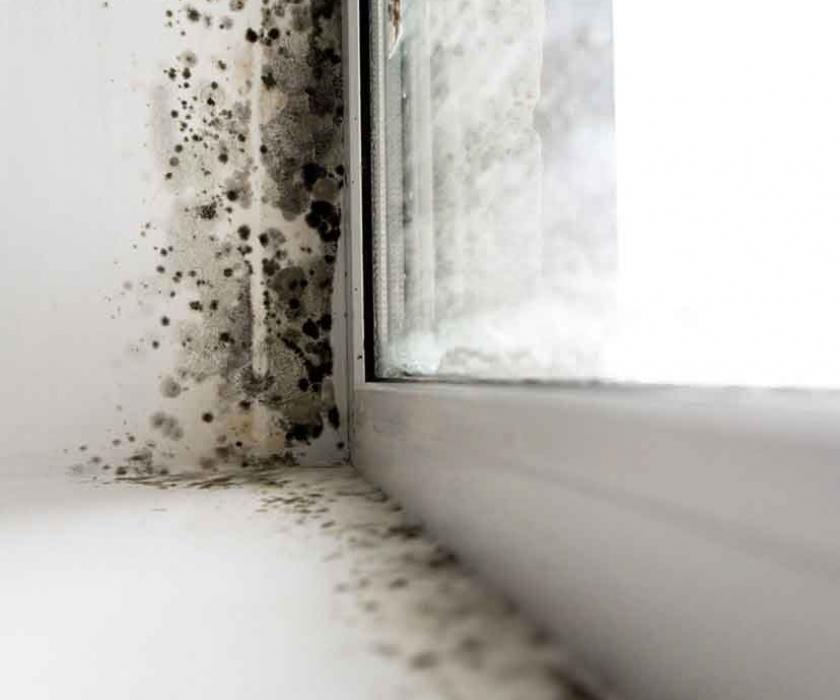
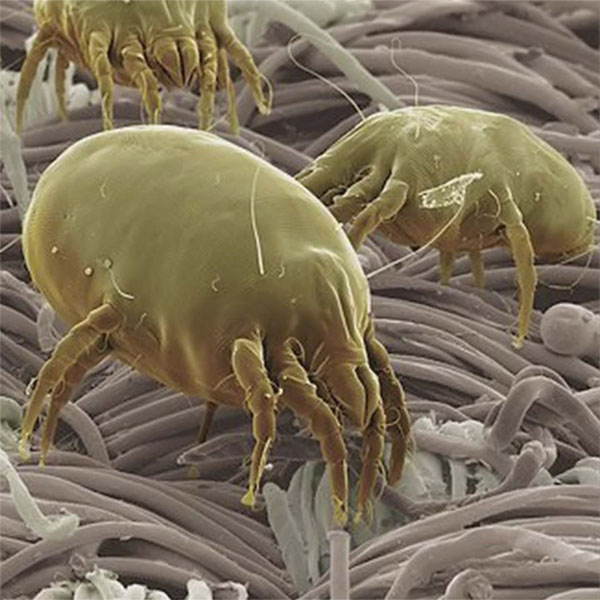
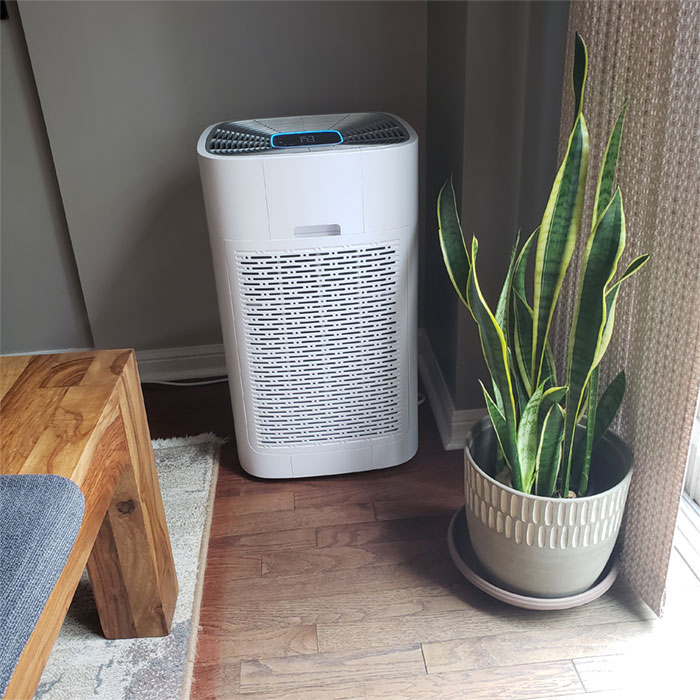
Portable Air Cleaner
To help remove airborne particle matters, choose a portable air cleaner with a clean air delivery rate (CADR) that is large enough for the size of the room or area for which it is intended for. The higher the CADR, the more particles will be filtered at less the time it will take compared to one with a lower CADR. Choose filters with HEPA (High Efficiency Particulate Air) rating of H13 or higher to filter out particles sizes of 0.3 microns at an efficiency level of at least 99.99%.
The CADR rating system is for particles only. To filter gases, choose also an air cleaner with an activated carbon filter and/or other filter designed to remove gases.
Fatalities and Cost of Dirty Air
In a 2021 report, Health Canada estimates that air pollution, including particle pollutants, contributes to 15,300 premature deaths per year in Canada. This is in addition to non-fatal health outcomes that include 2.7 million asthma symptom days and 35 million acute respiratory symptom days per year. The total economic cost of all health impacts attributable to air pollution for the year of 2016 is 120 Billion Canadian Dollars, approximately equivalent to 6% of Canada’s 2016 real gross domestic product.
REFERENCES
Canadian Centre for Occupational Health and Safety
US Environmental Protection Agency (EPA)
American Lung Association
The Harvard T.H. Chan School of Public Health
National Geographic Magazine
Impacts of Air Pollution in Canada 2021 Report, Health Canada
Urban Emissions Info
The World Health Organization (WHO)
sales
- Wholesale Inquiries: sales@aerione.com
